Phylum Chordata Scientific name Folivora | ||
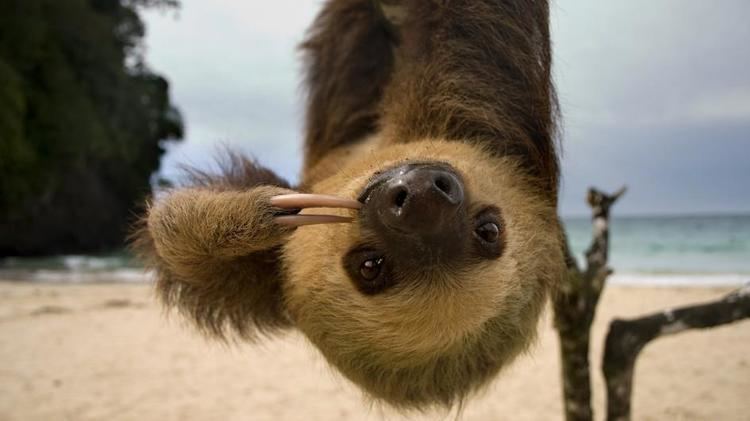 | ||
Suborder FolivoraDelsuc, Catzeflis, Stanhope, and Douzery, 2001 Daily sleep Brown-throated sloth: 15 – 18 hours Gestation period Pale-throated sloth: 183 days Mass Brown-throated sloth: 2.2 – 6.3 kg, Maned sloth: 4.5 – 10 kg, Pale-throated sloth: 3.8 – 6.5 kg Tail length Brown-throated sloth: 2.5 – 9 cm, Maned sloth: 5 cm, Pale-throated sloth: 4 – 6 cm Lower classifications | ||
Baby sloths being sloths animal compilations
Sloths are mammals classified in the families Megalonychidae (two-toed sloths) and Bradypodidae (three-toed sloths), including six extant species. They are named after the capital sin of sloth because they seem slow and lazy at first glance; however, their usual idleness is due to metabolic adaptations for conserving energy. Aside from their surprising speed during emergency flights from predators, other notable traits of sloths include their strong body and their ability to host symbiotic algae on their furs.
Contents
- Baby sloths being sloths animal compilations
- Taxonomy and names
- Ecology
- Physiology
- Evolution
- Phylogeny
- Classification
- Extinctions
- Conservation
- In popular culture
- References
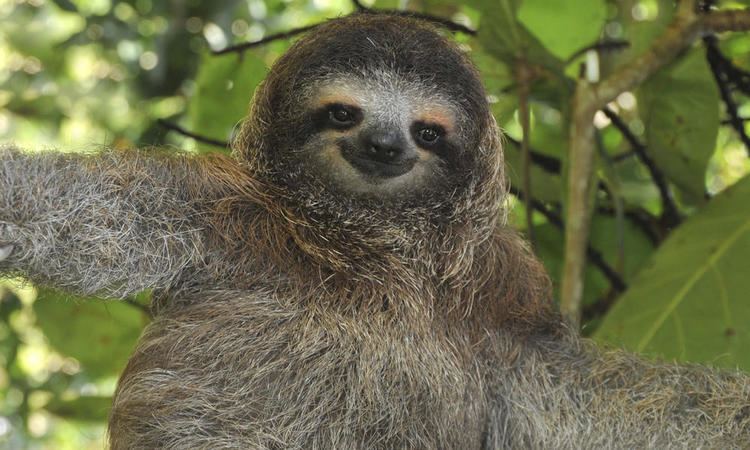
They are classified in the order Pilosa because they are related to anteaters, which sport a similar set of specialized claws. Extinct sloth species include many megafaunal ground sloths, some of which attained the size of elephants, as well as a few species of marine sloths. Extant sloths are medium-sized arboreal (tree-dwelling) residents of the jungles of Central and South America.
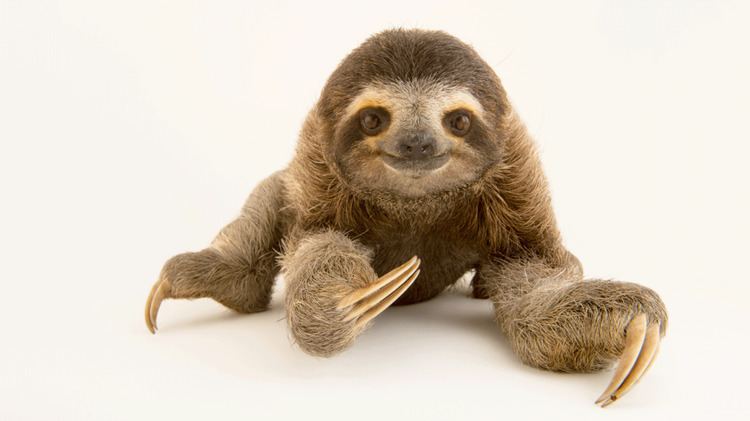
Sloths make good habitats for other organisms, and a single sloth may be home to moths, beetles, cockroaches, fungi, ciliates, and algae.
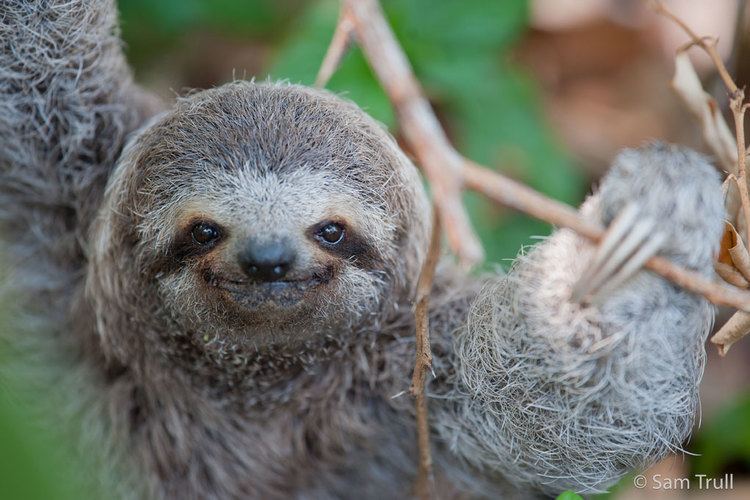
Taxonomy and names
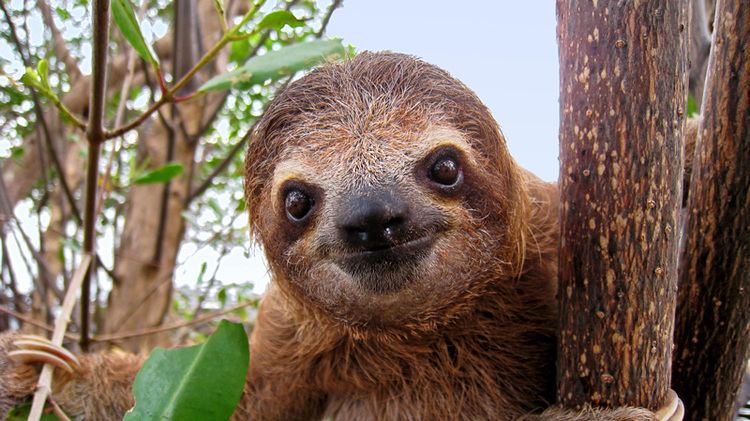
The sloth's taxonomic suborder is Folivora, sometimes also called Phyllophaga (Owen, 1842) or Tardigrada (Latham and Davies, 1795). The first two names both mean "leaf-eaters"; derived from Latin and Greek, respectively. Names for the animals used by tribes in Ecuador include ritto, rit, and ridette, mostly forms of the word "sleep", "eat", and "dirty" from Tagaeri tribe of Huaorani.
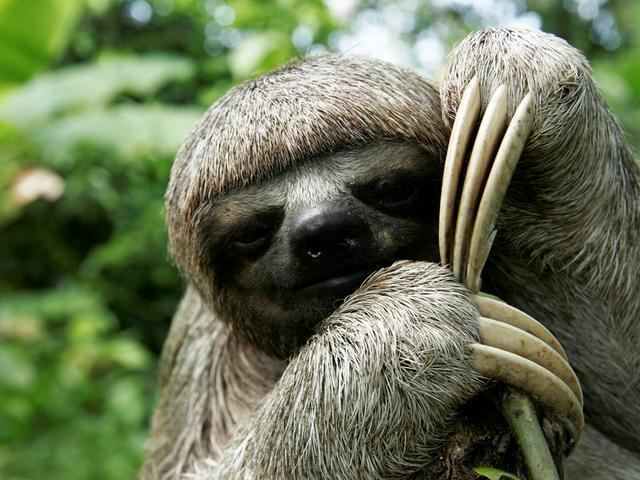
The English word "sloth" (a derivative of the adjective "slow") is recorded as meaning "laziness", "indolence" from the twelfth century onwards, and is considered as one of the seven cardinal sins. It was applied to the animal in the early seventeenth-century, as a calque of the Portuguese preguiça ("laziness"). The pronunciation is /ˈsloʊθ/ SLOHTH or /ˈslɒθ/ SLOTH.
Ecology

Sloths are classified as folivores, as the bulk of their diets consist of buds, tender shoots, and leaves, mainly of Cecropia trees. Some two-toed sloths have been documented as eating insects, small reptiles, and birds as a small supplement to their diets. Linnaeus's two-toed sloth has recently been documented eating human faeces from open latrines. They have made extraordinary adaptations to an arboreal browsing lifestyle. Leaves, their main food source, provide very little energy or nutrients, and do not digest easily. Sloths, therefore, have large, specialized, slow-acting stomachs with multiple compartments in which symbiotic bacteria break down the tough leaves. Sloths' tongues have the unique ability to protrude from their mouths 10 to 12 inches (25 to 30 cm), an ability that is useful for collecting leaves just out of reach. As much as two-thirds of a well-fed sloth's body weight consists of the contents of its stomach, and the digestive process can take a month or more to complete.
Since leaves provide little energy, sloths deal with this by a range of economy measures: they have very low metabolic rates (less than half of that expected for a mammal of their size), and maintain low body temperatures when active (30–34 °C or 86–93 °F), and still lower temperatures when resting.
Although unable to survive outside the tropical rainforests of South and Central America, within that environment sloths are outstandingly successful creatures. On Barro Colorado Island in Panama, sloths have been estimated to comprise 70% of the biomass of arboreal mammals. Four of the six living species are presently rated "least concern"; the maned three-toed sloth (Bradypus torquatus), which inhabits Brazil's dwindling Atlantic Forest, is classified as "vulnerable", while the island-dwelling pygmy three-toed sloth (B. pygmaeus) is critically endangered.
Physiology
Sloth fur exhibits specialized functions: the outer hairs grow in a direction opposite from that of other mammals. In most mammals, hairs grow toward the extremities, but because sloths spend so much time with their legs above their bodies, their hairs grow away from the extremities to provide protection from the elements while the sloth hangs upside down. In most conditions, the fur hosts two species of symbiotic algae, which provide camouflage. Because of the algae, sloth fur is a small ecosystem of its own, hosting many species of non-parasitic insects. Sloths have short, flat heads, big eyes; short snouts, long legs, and tiny ears. Some species have stubby tails (6–7 cm long). Altogether, sloths' bodies usually are between 50 and 60 cm long.
Sloths' claws serve as their only natural defense. A cornered sloth may swipe at its attackers in an effort to scare them away or wound them. Despite sloths' apparent defenselessness, predators do not pose special problems: sloths blend in with the trees and, moving only slowly, do not attract attention. Only during their infrequent visits to ground level do they become vulnerable. The main predators of sloths are the jaguar, the harpy eagle, and humans. The majority of recorded sloth deaths in Costa Rica are due to contact with electrical lines and poachers. Their claws also provide a further unexpected deterrent to human hunters; when hanging upside-down in a tree, they are held in place by the claws themselves and often do not fall down even if shot from below.
Despite their adaptation to living in trees, sloths (like many other rainforest animals) make competent swimmers. This is likely to have been true of the extinct ground sloths, as well, as evidenced by the fact that megalonychid sloths were able to colonise the Antilles by the Oligocene, and that the megalonychid Pliometanastes and the mylodontid Thinobadistes were able to colonise North America about 9 million years ago, well before the existence of the Isthmus of Panama. Additionally, the nothrotheriid Thalassocnus of the west coast of South America became adapted to a semiaquatic marine lifestyle.
Sloths move only when necessary and even then very slowly; they have about a quarter as much muscle tissue as other animals of similar weight. They can move at a marginally higher speed if they are in immediate danger from a predator (4 m or 13 ft per minute for the three-toed sloth), but they burn large amounts of energy doing so. Their specialised hands and feet have long, curved claws to allow them to hang upside down from branches without effort. While they sometimes sit on top of branches, they usually eat, sleep, and even give birth hanging from limbs. They sometimes remain hanging from branches after death. On the ground, the maximum speed of the three-toed sloth is 2 m or 6.5 ft per minute.
Sloths were thought to be among the most somnolent animals, sleeping from 15 to 18 hours each day. In 2008, however, Dr. Neil Rattenborg and his colleagues from the Max Planck Institute for Ornithology in Starnberg, Germany, published a study testing sloth sleep patterns in the wild; this is the first study of its kind. The study indicated that sloths sleep just under 10 hours a day. Three-toed sloths are mostly diurnal, while two-toed sloths are nocturnal.
Sloths go to the ground to urinate and defecate about once a week, digging a hole and covering it afterwards. They go to the same spot each time and are vulnerable to predation while doing so. The reason for this risky behaviour is unknown, although some believe it is to avoid making noise while defecating from up high that would attract predators. Consistent with this, they reportedly relieve themselves from their branches during storms in the rainy season. Another possible explanation is that the middens provide the sloths with one of their few methods of finding one another for breeding purposes, since their sense of smell is far more acute than their eyesight or hearing. Still other recent studies have suggested that it might be relevant for maintaining the ecosystem in the sloths' fur. Individual sloths tend to spend the bulk of their time feeding on a single "modal" tree; by burying their excreta near the trunk of that tree, they may help nourish it. Recently there has been some speculation that sloths go to the ground to defecate because of their mutually beneficial relationships with moths. While the sloth defecates, female moths that otherwise live on a sloth will get off and immediately lay their eggs directly on the fecal matter, on which the larvae survive until they mature to adulthood and are able to fly onto sloths. Incidentally, it appears that sloths benefit from their relationship with moths because the moths are responsible for fertilizing algae on the sloth, which provides them with nutrients.
Infant sloths normally cling to their mothers' fur, but occasionally fall off. Sloths are very sturdily built and rarely die from a fall. In some cases, they die from a fall indirectly because the mothers prove unwilling to leave the safety of the trees to retrieve the young. Females normally bear one baby every year, but sometimes sloths' low level of movement actually keeps females from finding males for longer than one year. Sloths are not particularly sexually dimorphic and several zoos have purchased sloths of the wrong sex.
Almost all mammals have seven cervical vertebrae (neck bones), including those with very short necks, such as elephants or whales, and those with very long necks, such as giraffes). The few exceptions include manatees and two-toed sloths, which each have only six cervical vertebrae, and three-toed sloths with 9 cervical vertebrae.
Evolution
Sloths are members of the superorder Xenarthra, a group of mammals that appeared in South America about 60 million years ago (Mya), although at least one source puts the date at which sloths and related animals broke off from other placental mammals at about 100 Mya. Also included among the Xenarthra are anteaters and armadillos. The earliest xenarthrans were arboreal herbivores with sturdy spines, fused pelvises, stubby teeth, and small brains.
The living sloths belong to one of two families, known as the Megalonychidae ("two-toed" sloths) and the Bradypodidae (three-toed sloths). All living sloths have in fact three toes; the "two-toed" sloths, however, have only two fingers. Two-toed sloths are generally faster-moving than three-toed sloths. Both types tend to occupy the same forests; in most areas, one species of three-toed sloth and one species of the larger two-toed type will jointly predominate.
However, their adaptations belie the actual relationships of the living sloth families, which are more distant from each other than their outward similarity suggests. The common ancestor of the two families apparently lived 35–40 Mya, making the living forms exceptional examples of convergent or parallel evolution. The two-toed sloths of today are far more closely related to one particular group of ground sloths than to the living three-toed sloths. Whether these ground-dwelling Megalonychidae were descended from tree-climbing ancestors or whether the two-toed sloths are really miniature ground sloths converted (or reverted) to arboreal life cannot presently be determined to satisfaction. The latter possibility seems slightly more likely, because the small ground sloths Acratocnus and Neocnus, which were also able to climb, are among the closer relatives of the two-toed sloths, and these together were related to the huge ground sloths Megalonyx and Megalocnus.
The evolutionary history of the three-toed sloths is not well known. No particularly close relatives, ground-dwelling or not, have yet been identified.
The ground sloths do not constitute a monophyletic group. Rather, they make up a number of lineages, and as far as is known, until the Holocene, most sloths were in fact ground-dwellers. The famous Megatherium, for example, belonged to a lineage of ground sloths that was not very close to the living sloths and their ground-living relatives, like the small Neocnus or the massive Megalonyx. Meanwhile, Mylodon, among the last ground sloths to disappear, was only very distantly related to either of these.
Phylogeny
The following sloth phylogeny was obtained by morphological analysis of craniodental characters, and places Bradypus as the sister group to all other extant and known extinct sloths (extant genera are in bold).
However, a limited 2016 study of retrovirus and mitochondrial DNA sequences groups Choloepus with Mylodon, and Bradypus with Nothrotheriops.
Classification
Suborder Folivora (sloths)
Extinctions
Until about 10,000 years ago, ground sloths such as Megatherium lived in South America as well as in much of North America; they colonized the latter as part of the Great American Interchange. Along with many other animals, however, they disappeared shortly after the appearance of humans on both continents. Much evidence suggests human hunting contributed to the extinction of the American megafauna (including giant ground sloths), like that of far northern Asia, Australia, New Zealand, and Madagascar. Simultaneous climate change that came with the end of the last ice age may have also played a role in some cases. However, the survival of ground sloths on the Antilles until about 5000 years ago (after these islands were finally settled by humans), long after they had died out on the mainland, points toward human activities as the agency of extinction.
In Peru and Chile, sloths of the genus Thalassocnus adapted to a coastal marine lifestyle beginning in the late Miocene. Initially they just stood in the water, but over a span of 4 million years they eventually evolved into swimming creatures. It is thought that when the Isthmus of Panama closed about 3 million years ago the water grew colder, perhaps contributing to their extinction by the late Pliocene. The plants these sloths fed on may have grown sparse, or they may have been unable to adapt to the lower water temperatures.
Conservation
In Costa Rica, the Aviarios Sloth Sanctuary cares for wounded and abandoned sloths. About 130 animals have been released back into the wild. However, a report in May 2016 featured two former veterinarians at the facility who were intensely critical of the sanctuary's efforts, accusing the sanctuary of mistreating the animals. The Sloth Institute Costa Rica is also known for caring, rehabilitating and releasing sloths back into the wild.
In popular culture
Sloths increased in popularity during the early 21st century, with the release of the first of the Ice Age movies, which featured Sid, a prehistoric ground sloth, as a central character. As of 2013, there are four Ice Age movies, with the fifth planned to come out on the 15th of July, 2016. The Croods, which came out in 2013, features a sloth as a family pet. In Disney's animated film Zootopia, Flash is a sloth who along with other sloths works at the DMV, who all speak and perform various actions extremely slowly, much to the other characters' frustration.
